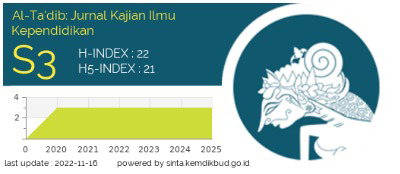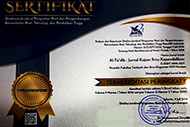Gambaran Kesenangan Belajar IPA dan Ketertarikan Berkarir di Bidang IPA Siswa Sekolah Menengah Pertama
Abstract
Full Text:
PDFReferences
Aschbacher, P. R., Li, E., & Roth, E. J. (2010). Is science me? High school students’ identities, participation and aspirations in science, engineering, and medicine. Journal of Research in Science Teaching, 47(5), 564–582. https://doi.org/10.1002/tea.20353
Astalini, A., & Kurniawan, D. A. (2019). Pengembangan instrumen sikap siswa sekolah menengah pertama terhadap mata pelajaran IPA. Jurnal Pendidikan Sains, 7(1), 1–7. https://doi.org/10.26714/jps.7.1.2019.1-7
Astalini, Kurniawan, D. A., Perdana, R., & Patoni, H. (2019). Identifikasi sikap peserta didik terhadap mata pelajaran fisika di Sekolah Menengah Atas Negeri 5 Kota Jambi. Unnes Physics Education Journal, 8(1), 34–43. https://doi.org/10.15294/upej.v8i1.29510
Astalini, Kurniawan, D. A., & Putri, A. D. (2018). Identifikasi sikap implikasi sosial dari IPA, ketertarikan menambah waktu belajar IPA, dan ketertarikan berkarir di bidang IPA siswa SMP se-Kabupaten Muaro Jambi. Jurnal Tarbiyah: Jurnal Ilmiah Kependidikan, 7(2), 93–108.
Bang, E., & Baker, D. R. (2013). Gender differences in Korean high school students’ science achievements and attitudes towards science in three different school settings. Mevlana International Journal of Education, 3(2), 27–42. https://doi.org/10.13054/mije.13.11.3.2
DeWitt, J., & Archer, L. (2015). Who aspires to a science career? A comparison of survey responses from primary and secondary school students. International Journal of Science Education, 37(13), 2170–2192. https://doi.org/10.1080/09500693.2015.1071899
DeWitt, J., Archer, L., & Osborne, J. (2014). Science-related aspirations across the primary-secondary divide: Evidence from two surveys in England. International Journal of Science Education, 36(10), 1609–1629. https://doi.org/10.1080/09500693.2013.871659
DeWitt, J., Osborne, J., Archer, L., Dillon, J., Willis, B., & Wong, B. (2013). Young children’s aspirations in science: The unequivocal, the uncertain and the unthinkable. International Journal of Science Education, 35(6), 1037–1063. https://doi.org/10.1080/09500693.2011.608197
Falentini, F. Y., Taufik, & Mudjiran. (2013). Usaha yang dilakukan siswa dalam menentukan arah pilihan karir dan hambatan-hambatan yang ditemui (Studi deskriptif terhadap siswa SMAN 1 Payakumbuh). Konselor: Jurnal Ilmiah Konseling, 2(1), 310–316. https://doi.org/10.24036/02013211266-0-00
Fraser, B. J. (1981). Tosra: Test of science-related attitudes: Handbook. Australia: Australian Council for Educational Research.
Jufrida, J., Kurniawan, W., Astalini, A., Darmaji, D., Kurniawan, D. A., & Maya, W. A. (2019). Students’ attitude and motivation in mathematical physics. International Journal of Evaluation and Research in Education (IJERE), 8(3), 401–408. https://doi.org/10.11591/ijere.v8i3.20253
Kurniawan, D. A., Astalini, & Anggraini, L. (2018). Evaluasi sikap siswa SMP terhadap IPA di Kabupaten Muaro Jambi. Jurnal Ilmiah Didaktika, 19(1), 124–139.
Maharaj-Sharma, R., & Sharma, A. (2017). Using ICT in secondary school science teaching - What students and teachers in Trinidad and Tobago say? European Journal of Education Studies, 3(2), 197–211. https://doi.org/10.5281/zenodo.251163
Maison, Astalini, Kurniawan, D. A., & Sholihah, L. R. (2018). Deskripsi sikap siswa SMA negeri pada mata pelajaran fisika. Edusains, 10(1), 160–167.
Manasia, L. (2015). Enjoyment of learning in upper secondary education. An exploratory research. Procedia - Social and Behavioral Sciences, 180, 639–646. https://doi.org/10.1016/j.sbspro.2015.02.172
OECD. (2016). PISA 2015 results: Excellence and equity in education. Paris: PISA OECD Publishing. https://doi.org/10.1787/9789264266490-5-en
Potvin, P., & Hasni, A. (2014). Interest, motivation and attitude towards science and technology at K-12 levels: A systematic review of 12 years of educational research. Studies in Science Education, 50(1), 85–129. https://doi.org/10.1080/03057267.2014.881626
Pratiwi, N. K. (2015). Pengaruh tingkat pendidikan, perhatian orang tua, dan minat belajar siswa terhadap prestasi belajar bahasa Indonesia siswa SMK kesehatan di Kota Tangerang. Jurnal Pujangga, 1(2), 75–105. https://doi.org/10.47313/pujangga.v1i2.320
Saridewi, K., & Naqiyah, N. (2017). Pengembangan media pion perencanaan karier pada siswa kelas IX SMP Negeri 1 Besuki. Jurnal BK Unesa, 7(3), 89–98.
Sheldrake, R. (2020). Changes in children’s science-related career aspirations from age 11 to age 14. Research in Science Education, 50(4), 1435–1464. https://doi.org/10.1007/s11165-018-9739-2
Shin, S., Rachmatullah, A., Roshayanti, F., Ha, M., & Lee, J. K. (2018). Career motivation of secondary students in STEM: A cross-cultural study between Korea and Indonesia. International Journal for Educational and Vocational Guidance, 18(2), 203–231. https://doi.org/10.1007/s10775-017-9355-0
Sofyan, A., Yusuf, A. M., & Daharnis, D. (2018). Tingkat aspirasi karir siswa ditinjau dari jenis kelamin, jurusan dan daerah tempat tinggal. Jurnal Konseling dan Pendidikan, 1(3), 9–27. https://doi.org/10.29210/110800
Swarat, S., Ortony, A., & Revelle, W. (2012). Activity matters: Understanding student interest in school science. Journal of Research in Science Teaching, 49(4), 515–537. https://doi.org/10.1002/tea.21010
Tyler-Wood, T., Ellison, A., Lim, O., & Periathiruvadi, S. (2012). Bringing Up Girls in Science (BUGS): The effectiveness of an afterschool environmental science program for increasing female students’ interest in science careers. Journal of Science Education and Technology, 21(1), 46–55. https://doi.org/10.1007/s10956-011-9279-2
Wang, X. (2013). Why students choose STEM majors: Motivation, high school learning, and postsecondary context of support. American Educational Research Journal, 50(5), 1081–1121. https://doi.org/10.3102/0002831213488622
DOI: http://dx.doi.org/10.31332/atdbwv13i2.1557
Refbacks
- There are currently no refbacks.
Copyright (c) 2020 Erika ika

This work is licensed under a Creative Commons Attribution-NonCommercial-ShareAlike 4.0 International License.
| Indexing: |










